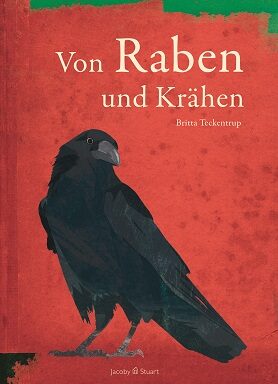Britta Teckentrup
Von Raben und Krähen
[All About Ravens and Crows]
- Jacoby & Stuart Verlag
- Berlin 2021
- ISBN 978-3-96428-089-3
- 160 Pages
- 7 Suitable for age 8 and above
- Publisher’s contact details
Published in Italian with a grant from Litrix.de.
Sample translations
Caw! Caw!
“Hoppe, hoppe, Reiter, / wenn er fällt, dann schreit er. / Fällt er in den Graben, / fressen ihn die Raben …” (“Horsey-riding bump bump bump / He falls and shouts oh no! / Into a ditch with one big thump / Then eaten by a crow”). It’s an old German children’s rhyme which small children love to listen to while sitting on a parent’s knee, full of tingling anticipation for the moment when they fall into the ditch – and relief not to be gobbled up by the black crows. Most adults’ earliest memories of ravens and crows go back to childhood: to this rhyme, and then to fairy-tales filled with crows perched on the shoulders of witches and wizards. Even as older schoolchildren, we encounter them again as signs of doom and gloom when we learn to recite Edgar Allan Poe’s gruesome poem “The Raven”.
Now along comes a book which completely turns all our long-held negative perceptions of these eerie, threatening birds on their head. Or, rather: Britta Teckentrup’s illustrated non-fiction book All About Ravens and Crows takes the long-cultivated false image of these winged creatures belonging to the Corvid (Corvidae) family – 129 species belonging to no fewer than 23 classes – and sets it firmly back on its feet. I am certainly not aware of any other book about birds which so expertly, clearly and not least poetically gives the reader such an insight into the lives of these remarkably diverse creatures. As one would expect, Teckentrup initially introduces us to the most highly developed species of the avian world which is found across several continents. So we find a whole host of ravens, crows, jays and magpies: Common Ravens, Hooded Crows, different types of Rook, House Crows, Jackdaws, Alaska Ravens, Cuban Crows, Green Magpies, Eurasian Jays, Black Crows, Bougainville Crows, Ratchet-tailed Treepies … and many more besides. The author puts their social behaviours into perspective, also elaborating on their breeding practices, their marked sense of family, their high intelligence, and their differing song. This in itself would be enough to demonstrate the ridiculous nature of the stubborn prejudices which so many people harbour where crows and ravens are concerned. These birds are far better than we have been led to believe!
This, however, isn’t what makes Teckentrup’s book stand out from the existing body of intelligent and well written non-fiction books about birds. What does raise it above the others, however, is the way in which the author (who is also the book’s illustrator) leads the readers into the wonderful world of birds – which often starts right by our own front doors. The odd thing is that although so many ravens and crows live in such close proximity to humans, and although they regularly feature in reports and documentaries in the media, very little is known about Corvidae. We all know that they are clever and that they are very sociable among their own kind – but then we invariably end up falling back on the the scary images from our childhoods.
With her atmospheric-yet-realistic digital collages, Britta Teckentrup takes precisely these negative images and shows them in an enchanting light. The magic of these pictures is quite astonishing, and takes away all our fear of the unknown. Flocks of black or dark grey birds, big and small, fly above harvested fields or silent forests in the morning mist. They strut across the pages, peck away at the snow for little crumbs to eat, sit in the branches of rowan trees, gather together in a huge, forked oak tree behind which the full moon just manages to break through the fog. They sit clamouring on an old garden fence, or all on their own on a rotten window sill, or they create a colony among the weeds of an overgrown disused airfield. Endless pictures which make us view our childhood images in a new and positive light.
The illustrations are all very different from one another – and so, too, are the accompanying texts which describe the various birds. This is no dry ornithological catalogue: Teckentrup weaves together myths and ancient stories about Corvids, observations about their interaction with humans, and the ways in which they have over the course of hundreds of years made themselves a nest in literature – from Aesop’s Fables via the fairy-tales of myriad cultures to the serious and satirical poetry of the 19th and 20th centuries. Joachim Ringelnatz wrote of “The Crow”: “… Sie torkelt scheue Ironie, / flieht souverän beschaulich. / Und wenn sie mich sieht, zwinkert sie / mir zu, doch nie vertraulich” (“… Ironic sovereign of the skies / Sedate above me oh she flies / Sees me down below and winks / Though little of me she really thinks.”).
Yes, she winks at us, and might even croak her well known Caw! Caw! – but she saves her more intimate, soft, bubbly, chatty sounds for her children, her partner and her family. Her song is far more diverse than one might imagine. Ravens and crows have, as songbirds, been a protected species in Europe since 1972. After reading Britta Teckentrup’s book, we can understand why.
Translated by Helena Kirkby

By Siggi Seuß
Siggi Seuß, freelance journalist, radio script writer and translator, has been writing reviews of books for children and young people for many years.
Publisher's Summary
Did you know,
• what the difference is between ravens and crows?
• that in ancient Rome they were considered as prophets?
• that ravens have special warning calls for a.o. cats, for hawks or
for humans?
• that there are 250 different crow calls
• that raven can recognize people and remember faces
Ravens have in common with humans that they pass on acquired knowledge to following generations, which means, that they have something like what we call culture. And so, it is no wonder why ravens play such a large roll in religion, poetry, literature and art.
In this unique book all this, and much more is told in words and pictures by Britta Teckentrup.
(Text: Jacoby & Stuart Verlag)
